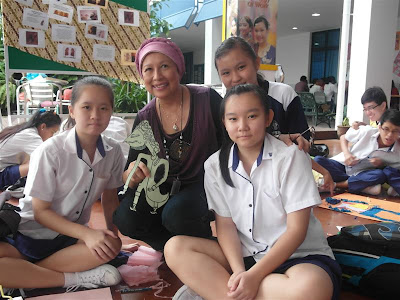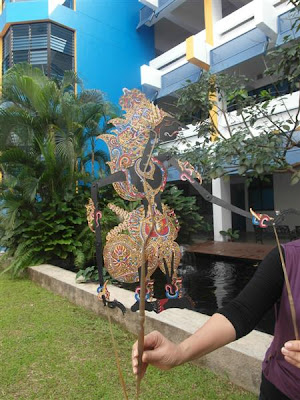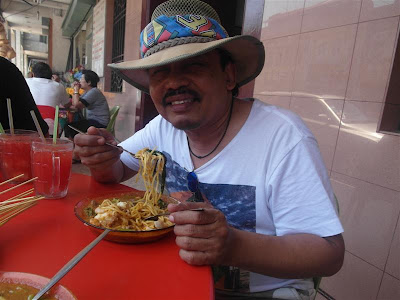
Watch the slideshow
The puppeteer holding the real wayang kulit

The group of students who took part in the event

We had judges to assess for the best wayang kulit 
Characters from Ramayana as their puppets

Nicole helped me with the photo taking

Explaining about wayang kulit to our guest of honour

Learning each other's culture

Arjuna the warrior was the name of our puppet

Groups of different races came together to take part
 Look at the intricate design of the wayang kulit  Planning the design from scratch

Puppet with a movable head and limbs SHADOW PLAY
Wayang Kulit or Shadow Play is popular in Malaysia, Bali and Thailand and it is a unique form of theatre employing light and shadow. The puppets which have movable head and limbs are carved, colourfully painted and intricately designed from buffalo skin. When held up behind a piece of white cloth, with an electric bulb or an oil lamp as the light source, shadows are cast on the screen.
The Tok Dalang or the puppeteer is the genius story teller who weaves his narration from orally handed down stories from past generations. He sits behind the screen and does not depend from any text but this cultural entertainment which lasts all night long is told from what comes in his mind. Not only has the Tok Dalang got to manipulate the puppets skillfully and gracefully but he has to modulate his voice to create suspense thus heightening the drama. Invariably, the play climaxes with the triumph of good over evil.
Wayang kulit is accompanied by gamelan musicians and the musical ensemble includes the serunai, which is a double-reeded wind instrument and the three drums; gendang, geduk and gedombak. Percussion instruments like gong, canai and kesi add to the regular beat of the song. The pemetek or the clappers are used to create effective sounds to express shadow puppets' movements like walking and running. I got my students to design their wayang kulit and they had to depend on their ingenuity and creative juice to bring their puppets alive. They were given some pieces of coloured paper and stationery items to do the puppets. Working in groups, the students had fun in coming up with their creation during our Artz and Sportz Carnival.
 The famous Mee Bandung Muar of Pak Abu The famous Mee Bandung Muar of Pak Abu Shrimps and meat pieces swim in the thick gravy Shrimps and meat pieces swim in the thick gravy Having my first taste of Pak Abu Mee Bandung Having my first taste of Pak Abu Mee Bandung  'John Wayne' also had a go of his mee bandung at Muar 'John Wayne' also had a go of his mee bandung at Muar Satay is eaten with peanut sauce, rice cubes and cucumber Satay is eaten with peanut sauce, rice cubes and cucumber

Pak Abu sells his gravy paste to his customers
Watermelon juice with a zest of lemon. Melonlicious!
Thanks for the generous portion Pak Abu 
Yusuf with the youngest customer of Pak Abu
The satay man fanning the charcoal for a good fire
Charcoal-grilled chicken and beef meat
The road opposite Wah San Coffee shop
Pak Abu Hanipah the man behind the success of Mee Bandung Muar 
Selling the box of paste for RM 10

ME AND MEE BANDUNG MUAR
After watching an episode of 'Warung Kita', I told my husband that we must stop by at Muar for the famous Mee Bandung and satay which were given the thumbs up by the foodie commentator. We were in Negri Sembilan recently and dropped by at Muar on the way back to Singapore. It took us about twenty minutes driving around Muar town to find the rightly named Wah San Coffeeshop which was highlighted in the programme. A row of big bikes from KL fronted the shop. The riders are regulars and would have their Sunday breakfast there. Cars with plates from Johor, Negri Sembilan and Selangor lined the road. That was a clear mandate that the iconic Pak Abu's Mee Bandung of Muar started in the 1930s and his hand-me-down secret recipe sill have its magnetism to pull in the crowd who are willing to drive hundreds of kilometres away. Stepping into the coffee shop gave us an aura of simplicity and a relaxing atmosphere; inviting and easy-going feeling which are only offered by people who want to see you revisit their stall. Pak Abu gave us his wide smile and bantered away at the list of guests who had been his patrons. Newspaper cuttings on 'Who's Who' in Malaysia political and entertainment scene were fighting for space on the walls of the shop and on his glass display cabinet. We planted ourselves at a table a long the five-foot path and ordered the speciality of the shop. I ventured into the cooking area. Pak Abu fried his paste of chillies, onions, peanut, beef and shrimp fresh before adding the stock, vegetables and the yellow mee into the big wok. His scooping of the condiments and giving a quick dash of sauce here and there into the wok with his ladle and deft hands reminded me of an image of a conductor holding a baton and making music with his orchestra. I marvelled at the quickness of how he portioned his ingredients that should go into the cooking of the gravy. Only a maestro of the ladle like him would be able to perform that! Pak Abu's recipe of forty years had satisfied the gastronomical desires of many local and faraway customers. The mee bandung served had a generous portion of thick gravy, shrimp and meat. To me, the gravy was more like a mixture of satay peanut sauce and the mee rebus gravy. A bit too sweet for my liking. As for the satay, I prefer mine to be coated with more spice such as coriander, fennel and lemon grass rather than the caramelised meat we had.
Getting to Muar: Take the Tangkak exit (Exit 235) from the North South Expressway and drive past Sg. Mati and Parit Bunga (Highway 23 and 5). Muar town is situated approximately 27km from the Tangkak exit.
|




